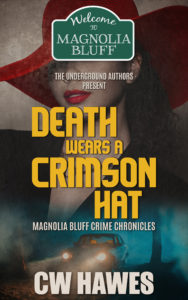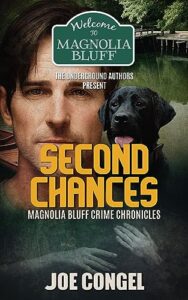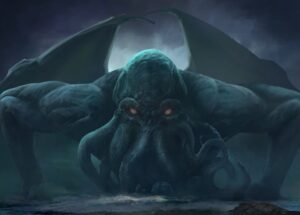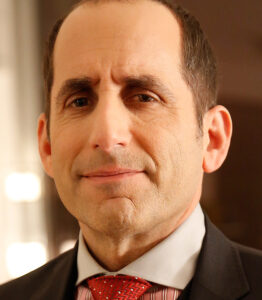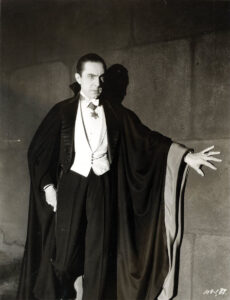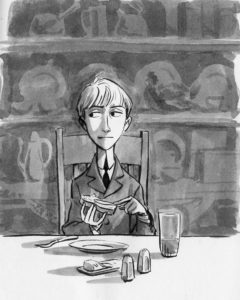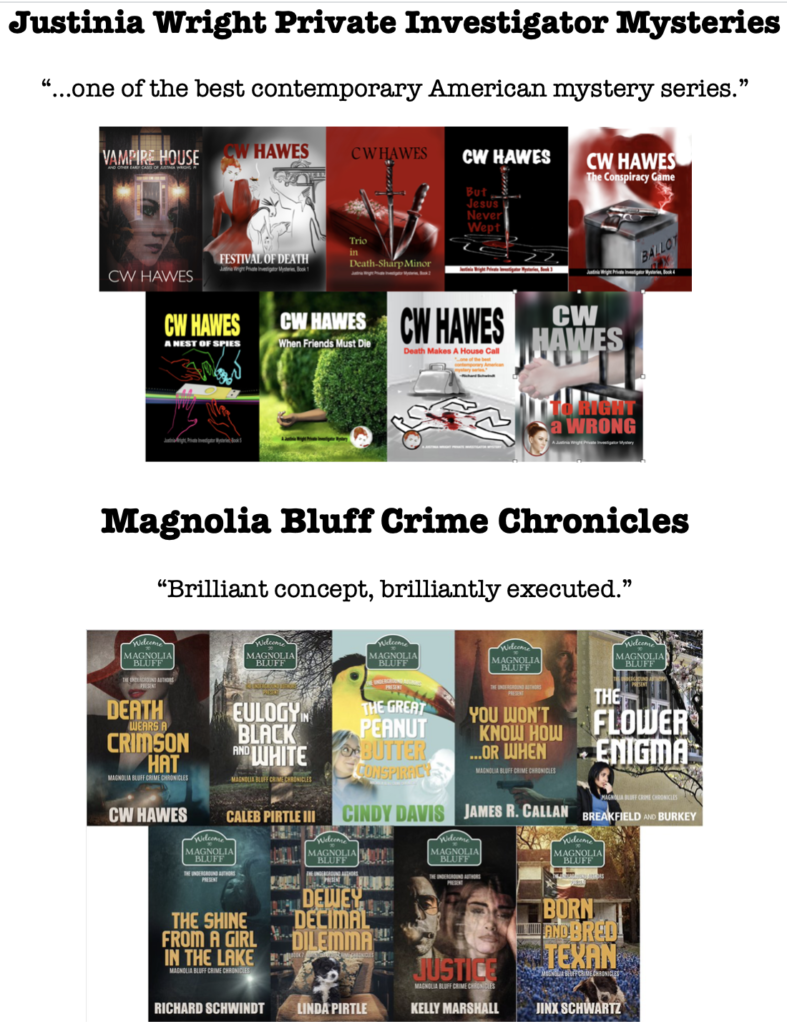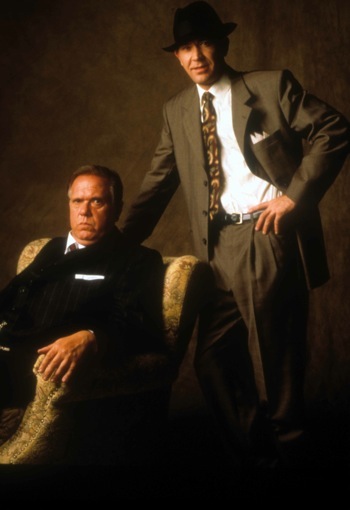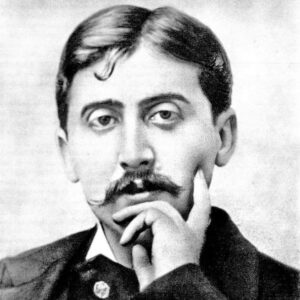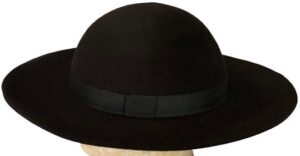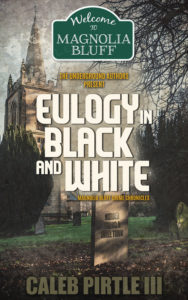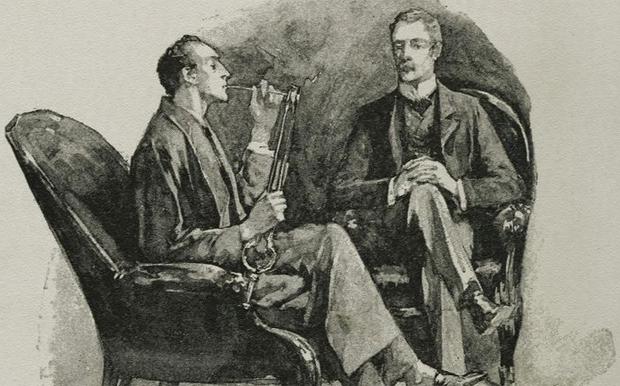A Review by Caleb Pirtle III
CW Hawes cleverly opens old wounds and reveals dark secrets as his story sets Magnolia Bluff on fire, and we watch it smolder and burn.
Reece Sovern is the chief detective in Magnolia Bluff.
His is not a difficult job.
Magnolia Bluff is usually quiet and peaceful, an eccentric little town near the shores of Burnet Reservoir.
He investigates the usual fare of crimes and misdemeanors.
A few thefts.
Burglaries.
Carjackings.
Nothing serious.
Of course, there’s the string of deaths that occur every May 23.
Been going on for several years.
Never solved.
Probably never will be.
Sovern only hopes the last one has died.
But in Death Wears A Crimson Hat, Book 1 of the Magnolia Bluff Crime Chronicles, he has another real crime to investigate.
One murder.
A hit and run.
He has lots of suspects.
He has hardly any evidence at all.
***
Enjoy an excerpt from Death Wears a Crimson Hat, available on Amazon.
Back in his office, Detective Reece Sovern pushed his glasses up and looked over his notes. Three people had seen the hit and run. No one had been able to catch the license plate number, and the three didn’t agree on make or model of the vehicle. They did agree that the car was a dark color. But whether it was black, navy blue, brown, or gray, not one of the three could say.
The vehicle seemed to come out of nowhere, hit Mary Lou as she began walking away from her car, and kept on going. Which told Sovern that the hit was probably intentional, rather than accidental.
He would have loved to talk to her, but at this point Mary Lou was in a coma and not talking to anybody.
“That’s the second Crimson Hat Society member in as many days,” he muttered. “Which is just a bit too coincidental for my liking.”
Aside from Mary Lou’s group, what did the two women have in common?
The cigar rolled from one corner of his mouth to the other. “From the looks of it, that’s all they had in common,” he said to his desk.
He looked at the ceiling and frowned. There was all the gossip flying around town concerning Mary Lou and Reverend Cole, which gave Ember Cole a motive.
After all, Mary Lou was threatening to get her canned from the church. At least that is what Ray Holden said, and he should know. He was after all the chairman of the pastor-parish relations committee.
Plenty of motive to kill someone who was threatening to destroy your career. And, sad to say, ministers weren’t exempt from the baser human passions.
With the reverend’s car at the garage and the forensics people crawling all over it, he’d know soon enough if her car was the one that had done in the Middlebrook woman.
His gaze shifted back to his notes. Unless Cole had gotten a car from someplace else or borrowed one from someone, she was off the hook for Mary Lou Fight. Unless she’d paid someone to do it. And that was a distinct possibility. In fact, it made a whole heck of a lot of sense to Sovern.
Then there was Harry Thurgood. “Now that’s a guy with a past if I ever saw one,” he muttered. “And he seems to be pretty thick with the Reverend. The gossips can’t miss an unmarried man and a single woman spending time together. Which means they might be in it together. Maybe I should take a look at Thurgood’s car. Although he seems too shrewd to use his own vehicle for something like this.”
Sovern took the cigar out of his mouth, looked at the soggy end, pitched it towards the wastebasket, missed, and took a fresh stogie from his desk drawer to replace it.
He leaned back in his desk chair, cigar jutting out of his mouth, hands behind his head, and said to the ceiling, “Don’t see sufficient motive to pin this on the Reverend or Thurgood. Maybe in time, but not right now.” He sat up. “But somebody had sufficient motive, and if it isn’t Cole or Thurgood, who is it? Then there’s that nutty hat group. Other than the society, what connects Fight and Middlebrook? Or is that it?”
He shook his head and stood. He had more people to interview, and that wasn’t going to happen sitting at his desk.
***
And there’s more of Reece Sovern in the upcoming Magnolia Bluff Crime Chronicle release: Second Chances by Joe Congel.
I’ve had a sneak peak of Second Chances and it’s going to be a fabulously good addition to the series. The book’s on pre-order at Amazon.
In the meantime, you can read the other books in the Magnolia Bluff Crime Chronicles series, if you haven’t already. Find them on Amazon.
And if you’ve read all the books in the series, while you’re waiting for Second Chances, you can read Joe’s Tony Razzolito PI mysteries. Find them on Amazon.
And you can read my own Justinia Wright PI mysteries, also on Amazon. Mysteries that are gently paced until the whizz-bang endings.
Comments are always welcome! And until next time, happy reading!
(This post originally appeared in a different form on calebandlindapirtle.com)
 CW Hawes is the author of the bestselling Death Wears a Crimson Hat; he’s also a playwright, screenwriter, fictioneer, and an award-winning poet. When not writing, he’s an armchair philosopher, political theorist, social commentator, and traveler. He loves a good cup of tea and agrees that everything’s better with pizza.
CW Hawes is the author of the bestselling Death Wears a Crimson Hat; he’s also a playwright, screenwriter, fictioneer, and an award-winning poet. When not writing, he’s an armchair philosopher, political theorist, social commentator, and traveler. He loves a good cup of tea and agrees that everything’s better with pizza.
If you enjoyed this post, please consider buying me a cup of tea. Thanks! PayPal.me/CWHawes
Share This!